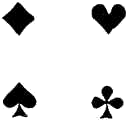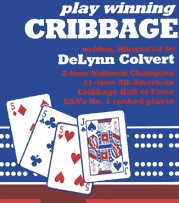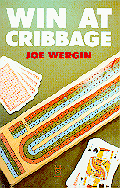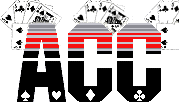A course of study
![]()
 |
This is the first in a series of articles
about cribbage strategy and technique. I've chosen Schellsburg
as the venue because publishing on the Web will let me reach the most
people with the least effort. Here, we can cover the game in enough detail
to interest advanced players, thus overcoming the space limitations of Cribbage
World and other vehicles. In this article, I'll outline a course of
study intended to make an average player into an expert.
But first a bit of background. For three decades I was a casual cribbage player. I'd learned the game as a kid in the 1970s, and had enjoyed playing with friends ever since. I was a decent enough player, winning a bit more often than not. After a few years away from cribbage, I discovered Internet play in late 1998, and became more serious about the game. Intent on reaching the expert level, I developed a system of study and training. I read and reread books and articles, practiced against my computer, took notes on my own games, and analyzed hands using a spreadsheet program. Having previously regarded cribbage as a simple game, I was surprised to learn how much knowledge separated the top-level players from the rest of us. Nevertheless, my hard work paid off, and within a year I attained the highest ranking among active cribbage players at MSN Gaming Zone, PlaySite and Burbs Cribbage Ladder, becoming the first player ever to do all three. So at the risk of sounding immodest, my system works! And now I'm going to give it to you. Books |
|
 |
The curriculum starts with reading, quite a
bit of it actually. I recommend you get a hold of DeLynn Colvert's Play
Winning Cribbage. Currently in its Third Edition, this book covers
basic discarding and pegging technique, as well as more complicated
endgame and psychological concepts. It's attractively illustrated, and
includes discard tables and other statistics, as well as some
"color" material on cribbage history and tournament play. If
you're only going to read one book on cribbage, make it this one. The
author has been National Champion four times, is the highest rated
tournament player in the history of the American
Cribbage Congress, and is widely regarded as the world's best
over-the-board player. With a track record like that, his advice warrants
close attention.
If you're serious about separating yourself from the cribbage playing masses, it is vital to master the concept of board strategy, in which your decisions to play offensively or defensively are governed by the score (or board position, to use cribbage parlance). Colvert introduces this concept in Play Winning Cribbage, but the best treatment of it is in John Chambers' Cribbage: A New Concept. This is the second book you should read, and you should go over it and Colvert's book again and again until you feel confident evaluating board position and formulating a playing strategy to meet it. Board strategy is a difficult concept to grasp: it requires study, lots of trial and error, and a willingness to reassess your habitual play of certain hands. It significantly increases the number of decisions you have to make during an average game, requiring a greater degree of mental focus than most players are accustomed to. Don't be discouraged if it takes you a while to get the hang of it. Practicing against a computer program is a good way to develop a feel for board strategy at minimal cost to your ego. One caveat about Chambers' book: it does gets its share of criticism from experienced players, since it contains some mathematical errors and a fair amount of questionable tactical advice. Fortunately most of the errors are in the details, and don't undermine the author's fundamental points. Besides, part of the process of learning the game is to independently evaluate different author's perspectives. As you'll discover, the "authorities" don't agree about every play. Concentrate on Chamber's discussion of board strategy, and don't assume that you have to agree with everything he recommends. Just make sure that when you do disagree, it's for a good reason, one that you can explain in words. Cribbage: A New Concept is currently in its Fifth Edition. |
|
 |
When you can comfortably handle the materials in these two books, then it's time to move on to the more advanced books on pegging and endgames by Dan Barlow. I'd start with Cribbage for Experts, then go over the endgame exercises in Miracles on Fourth Street. Fun with Cribbage also contains many useful articles on specific topics, similar to the columns he has written for MSN Gaming Zone and the ACC Tip Library. At this stage of your game, you might also find it useful to go over Joseph Petrus Wergin's Win at Cribbage, which has a number of useful pointers. The latter book is not terribly well organized, so you'll probably find it most helpful after you already have a good grasp of the fundamentals. Then you can mine it for the choice nuggets contained within its pages, in particular, the detailed discussions of a few specific hands that often prove tricky in practice. Keep reviewing all these books as you improve. You may be surprised how much you can learn in a second or third reading. Also see my review of Barlow's most recent book, Play Cribbage to Win. Personal databaseAs you work your way through these books, I recommend that you start keeping a database of typical six-card hands (for studying discarding) and four-card hands (for studying pegging). When you learn a new way to play a particular hand, make a corresponding entry in your database, and try out the play the next time you get that hand in a real game. A good example might be Colvert's advice (p. 24 and 57) to toss A-x to your own crib from A-2-3-4-x-x (the lowercase "x" stands for any ten-card, i.e. 10, J, Q or K). If you're accustomed to tossing x-x instead, put Colvert's play in your database, and try it at your next opportunity. Do the same for four-card pegging hands. Colvert suggests leading K from 5-J-Q-K (p. 31). Did you used to randomly toss out the J or Q instead? Make an entry for this hand, and try it his way. The next step is to start adding entries for hands that aren't in the books. When you encounter a troublesome hand in a game against a human or silicon opponent, make a note of it. If your subsequent analysis turns up a way to improve your play, make sure it goes in your database. Now you're moving beyond the information in textbooks into the analysis of your own game. The more you study and analyze, the larger your database will grow. Eventually you'll learn how to discard from 2-3-5-6-K-K as dealer, and what to lead from A-6-7-8 as pone. And that knowledge will be in your database. You can add discarding averages, endgame problems, statistics and anything else you find useful. Your database will be a trusted friend that will keep your game at a high level throughout your playing career. The technique of keeping a database of archetypical hands is borrowed from chess and backgammon pedagogy, where its effectiveness is well established. In a sense, you are writing your own instructional book, developing your own theory of the game. In future articles, I'll discuss how to analyze discard and play decisions, so that you can do your own evaluations. I recommend that you keep a printout of your database available as you play against your computer or on the Internet. If you encounter a hand that corresponds to one in your database, review your notes and activate (put into practice) your newfound knowledge. My personal database contains several hundred entries, organized into six- and four- card hands for both pone and dealer. When I'm playing regularly, I try to review a few hands each day. It's remarkable how often certain hands seem to repeat themselves. It's also remarkable how easily I forget things, so revisiting my database is a quick and efficient way to renew my accumulated cribbage knowledge. I keep my database in an Excel spreadsheet, but you can use custom software, a word processor or even index cards — whatever you feel comfortable with. Remember what I said about the authorities not agreeing on everything? Well, a database help to sort this out too. Go back to our example of A-2-3-4-x-x as dealer. Colvert tells you to toss A-x, but Chambers (p. 112) and Wergin (p. 88-9) advocate tossing 2-3 from the same hand. Holding 5-J-Q-K as pone? Colvert says lead the K, but Wergin (p. 61) recommends leading the Q, or even the 5, depending on board position. In cases like this, I suggest experimenting with each author's pet play. Do some analysis, then decide which play is best suited to your style. You may even decide to keep different plays in your arsenal to use for different board positions and opponents. (Leading from 5-J-Q-K is discussed in more detail in Card frequency in cribbage.) Opposition researchKeeping a database and learning how to evaluate hands is crucial to analyzing your own game. It's also a good idea to study your opponent's game. If you play someone regularly, keep notes on their tendencies. Do they lead from a pair, or save a pair for later? Will they pair your opening lead some, all or none of the time? Do they play an aggressive, conservative or mixed style of play? If you play over the board, are there any physical habits or tendencies that you've noticed? Knowing your opponent's habits isn't enough to overcome lousy cards, but it can occasionally be a lifesaver. Here's an example from a match I played on the Internet recently, a match I needed to win to reach the top ten at Burbs Cribbage Ladder. My opponent was a very strong player against whom I'd played two dozen games previously. I'd lost most of them, but at least I'd kept notes along the way. One thing I noticed was that she tended to lead from a pair of ten-cards, unless she had a pair of Js. In that case she would lead a different card, hoping to run a J trap later in the play. For example, holding 5-Q-Q-K, she would lead a Q. But holding 5-J-J-K, she would lead the K, not a J. It so happened that I was holding 6-10-10-J as dealer when she led...a J! It was a crucial juncture in the game, and although I ordinarily would have been reluctant to pair a J lead, in this case I was confident that if she had two Js, she wouldn't have led one of them. I paired her J, she replied with a 10, and the two points I scored proved critical a few deals later when I barely reached 121 points with my first count, going on to win a close match. Computer cribbage |
|
 |
I've mentioned playing against a computer, and there are several cribbage programs available, including many free ones. I think the most useful program for serious players is HALSCRIB 4, written by Hal Mueller. It plays possibly the strongest game of any computer cribbage program (its major claim to fame being that it has never been defeated in match play by another bot). It includes game logging, and a duplicate feature that lets you compare your play to the program's play of the same cards. It also has some very interesting analysis features that are not found in any other program, such as real-time advice on discarding, pegging and board strategy, and the ability to input a specific hand or pegging scenario for analysis. Other programs may have slicker graphics or a more sophisticated GUI, but none of them combine this many analysis features with a strong level of play. | |
  |
Other good freeware cribbage games are Keith Westley's Ultimate Cribbage, Craig Hessel's Cribbage for Windows 97 and Tim Schempp's Royal Cribbage 3.1. Ultimate Cribbage has excellent graphics, the best GUI of any cribbage program, and is highly customizable. It is also the only program I've seen that plays both modern six-card cribbage and the original five-card version that is still popular in the UK. It does not play a particularly strong game however. Cribbage for Windows 97 has duplicate play, and an endgame practice mode that lets you play out games from a 106-98* score (the asterisk in the score denotes the dealer). No other game I've seen has this feature, a marvelous way to develop your endgame skill. The program can also keep a running log of all your games. Its principal drawback is its non-scalable graphics, which were designed for compatibility with Windows 3.1, and tend to look small on today's high-resolution displays. Cribbage for Windows 97 plays a pretty solid board strategy, and has some specialized pegging routines that make it a much stronger player than Ultimate Cribbage. Stronger still, however, is Royal Cribbage 3.1, which I review in detail here. This program has very pleasant graphics and an easy-to-use GUI, and its advanced implementation of board strategy makes it a very tough opponent. It also has some interesting analysis features, although they only work for the game in progress, and cannot be applied to hands or pegging situations that you input yourself. All of these programs can track your and your opponent's average hand, points per crib, and points per play. I would trust Cribbage for Windows 97's statistics over the others though, since it's the only program that excludes the final hand of each game (which is often played without regard for discarding averages) from the tabulations. I'd expect an expert human player to bat at least .600 against Ultimate Cribbage, .550 against Cribbage for Windows 97, .530 against Royal Cribbage 3.1 and perhaps a bit less than that against HALSCRIB 4. Nevertheless, any of these games will make a good sparring partner. You'll be able to monitor your improvement by keeping track of how well you do against them over time. With so many good free games available, I'm not sure why you would want to pay for a commercial program. However, one you might consider buying is Cribbage Master, which was written by Bruce Bowman, and which will cost you $50. Cribbage Master runs in DOS, and has never been updated for a 32-bit environment. It is also copy-protected. Despite all that, many expert players swear by it. It has a number of unusual features, including a solitaire mode for practicing hand counting, a discard analysis tool, and a "Discard Master" that lets you practice discarding as dealer and pone. In terms of playing strength, the program is about on a par with Cribbage for Windows 97. Cribbage Master seems to run OK in Windows 95/98/Me, but if you're running Windows 2000 or later you might want to check with the author beforehand to make sure it's compatible with your system. One final program you should get is Max Kassler's Hand Evaluator. Although it doesn't actually play cribbage, it's an indispensable tool for analyzing discards. Read my review here. Wrapping it upNow for some disclaimers and a closing word. If you've played any cribbage at all, you know that this game of ours has a high luck component. You can play perfectly, and still lose to a weak player who gets better cards. Personally, I consider cribbage 2/3 luck and 1/3 skill, by which I mean that roughly 2/3 of your games (assuming you're playing someone at least minimally competent) will be decided by the cards alone. Of that 2/3, you'll win half and lose half, so what you're really fighting over are the remaining 1/3 whose outcome you actually control. If you're an expert playing a rank beginner, you'll win all of these contestable games. If you're playing someone of equal strength you will, of course, split them, and if you're playing a stronger player, you'll lose more than you win. But the point is: even an expert playing a novice is going to lose at least 1/3 of the time. In 1999 I witnessed the spectacle of the defending National Champion losing to a 10-year-old boy who'd just lost seven consecutive games in his first over-the-board cribbage tournament. Don't expect that you can win every game, no matter how hard you study! |
|
 |
To put it in better perspective, consider DeLynn Colvert, arguably the world's greatest tournament player. His winning percentage on the ACC Tournament Trail is "only" .581 (according to Play Winning Cribbage). Granted, that's against the cream of the crop, but it's still a lot closer to 50% than it is to 100%. George "Ras" Rasmussen, an ACC Life Master, tells me he bats .560 in tournament play and .580 in Grass Roots play. On the Internet, the standard of play is generally much lower, although it is quickly improving, and you can already find some very strong players at the top. I personally bat about .590 on the Internet and in Grass Roots, and about .550 on the Tournament Trail. If you're an average player looking to improve your game, I think a reasonable goal is to win at least 55% of the time on the Internet and 52% of the time in Grass Roots. If you can bat even a single point over .500 in ACC-sanctioned tournaments, pat yourself on the back for holding your own against the world's best. I don't claim to be a world-class player of the caliber of a Phyllis Schmidt, Bob Julian or any of the players mentioned above. But I have had some success, so I trust that much of what I've said will be useful to you if — like me — you've endeavored to make the transition from an average player to an expert. The books I've listed above amply cover the basics, so in future articles I plan to concentrate on advanced topics. We'll be analyzing some specific hands in more detail than you'll find in any book, and look at a few scenarios that don't seem to get into the books at all. Feel free to adapt what I've said to suit your own needs. The best system for improving your play will be one that is customized to your goals, schedule, temperament and style. And feel free to contact me. I may not be able to respond right away, but I'll occasionally devote a column to reader's questions and comments. Hopefully you can teach me a few things to use in my own game, and we'll share them here. Good luck! - January 2000 (updated January 2002) |
![]()
 prior
article | Cribbage Forum home | next
article
prior
article | Cribbage Forum home | next
article
Schellsburg home
![]()
Cribbage Forum features articles on cribbage strategy and tactics
by Michael Schell.
Original Material and HTML Coding Copyright © 2000-2 by Michael Schell. All
Rights Reserved.